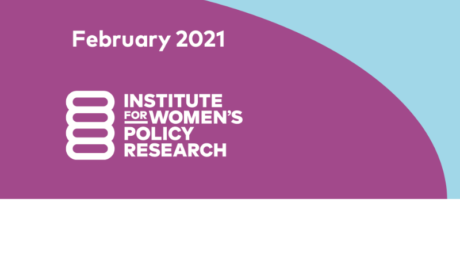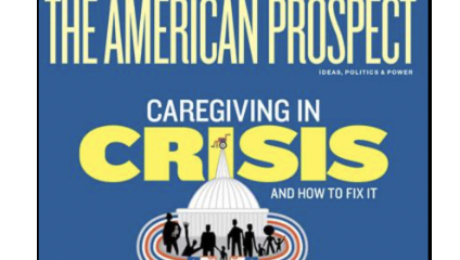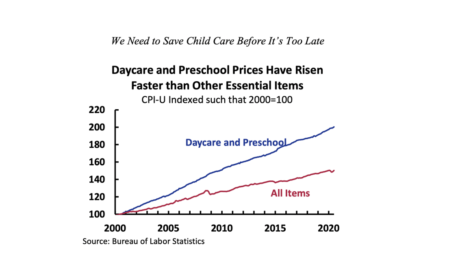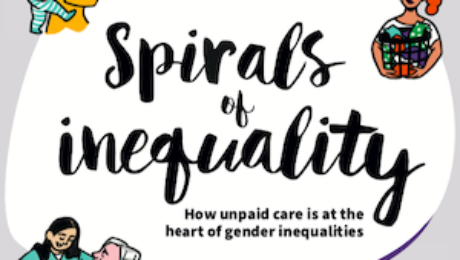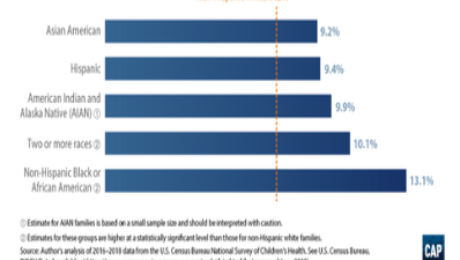Women and the Pandemic in the U.S.
Institute for Women’s Policy Research released a report in February 2021”IWPR Women’s Priorities and Economic Impact Survey” outlining a recent poll of 1452 women in the U.S. The findings are backdropped by the experience of women throughout the pandemic and resulting economic turndown, in which 2.35 million women have left the workforce since February 2020.
Some of the key findings from this survey are:
- 1 in 4 women report that they are worse off financially than one year ago
- Nearly half of all women are worried about the financial situation of their families
- 1 in 4 women report having needed to take time work off but did not do so
- 40% of women reported care demands stopped them from working or forced them to reduce hours
- 69% of women support paid sick time to have a child, recover from a serious health condition, or care for a family member
- 20% of women with children want the Biden administration to address childcare and education in the first 100 days
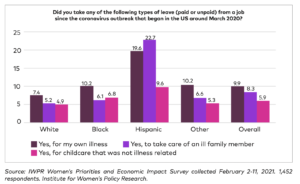
In terms of women experiencing reduced paid work as a result care demands, this has also been pointed to within recent working papers put out by the
The impact of care demands on women’s paid work is explored in a number of Care Work and the Economy Working Paper Series. For instance in two recent papers, “Gender Wage Equality and Investments in Care: Modeling Equity and Production” and “Parental Caregiving and Household Dynamics”.
Education and childcare were listed among the top priorities for the Biden administration to address within the first 100 days among survey participants. This is largely because women’s ability to reenter the workforce largely depends upon safe reopening of schools and childcare facilities.
Latinas have been hit particularly hard according to this survey, reporting the highest levels of taking leave from jobs in order to provide care. However, across all ethnicities, 69 percent of women expressed strong support for paid sick leave and the ability to take time away from work to provide care or recover from illness.
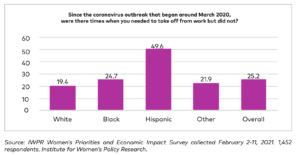
The Unites States remains the only high-income country in in the world that fails to provide guaranteed paid sick or family leave for workers. The Family Medical Leave Act, which provides unpaid job protection, and only for about 56 percent of workers. The Families First Coronavirus Relief Act has provided access to paid leave as a result of the pandemic but falls short in the fact that more than 100 million workers are excluded from this because they are caregivers.
In order to address the many issues identified throughout this survey, there is strong need for targeted programs and policy solutions that will aid a gender equitable recovery. This recovery should not only address immediate short term needs but include long term strategies that will create more resilient systems that recognize the contributions of women to the workforce, society and family structure.
IWRP specific recommendations for the short term are:
- Continuing economic impact payments
- Expanding access to affordable healthcare
- Providing paid sick and medical leave
- Raising the federal minimum wage
- Building a new childcare infrastructure
Equitable economic recovery necessitates a national care system that meets the needs of all families, raises wages and provides quality childcare, treating it as a public good instead of a private obligation.
This blog was authored by Jenn Brown, CWE-GAM Communications Assistant
- Published in Child Care, Gender Inequalities, Policy, Policy Briefs & Reports, U.S.
A New National Model for Preschool and Childcare in the U.S.
Frustrated with decades of inaction at the national and state level, residents of Multnomah County, Oregon put a measure on the ballot this past November to create a free, year-round, universal preschool program for all three and four year-olds in the county. Approval was resounding, the vote nearly two to one in support.
Despite years of compelling evidence for universal preschool as a powerful economic development strategy that improves educational outcomes while fighting poverty and inequality, as well as gender and racial disparities, the U.S. lags far behind many nations in the provision of early childhood education and care. But – unlike other desperate needs such as affordable housing and health care – early childhood education is relatively inexpensive, making it possible for a city or county to mount its own program.
The preschool model being created for the city of Portland, and the rest of Multnomah County, should set a new standard for public preschool programs in the U.S., meeting the needs of children, their families and preschool staff. To help children thrive and obtain the most from their later education, Multnomah County will work with a range of providers to offer a high quality program, in different languages and cultures, and in a variety of settings, including schools, centers, and family child care. The program will attain full universality within ten years, prioritizing the enrollment of children from communities of color and families with lower incomes in the early years as the program builds.
To ensure that the program works for families, they’ll also have a choice of schedules, including full and part-time, school year or year-round, and weekends as well as week days, for up to five days a week. All children may attend without cost for up to six hours a day, with ten hours a day free for families in the lower half of the income distribution.
To retain the skilled, experienced, dedicated – and almost entirely female – staff so critical to quality, teachers’ salaries will double the going rate, to equal those of kindergarten teachers. The wage floor for all classroom workers, including aides and assistant teachers, will be significantly above the minimum wage, starting at just under $20 an hour in the autumn of 2022 when the first children will be enrolled.
No public preschool system in the U.S. has yet paid a living wage to all staff members, despite cripplingly low levels of staff retention. Economist Catherine Weinberger has shown that, in the U.S., four of five employed women with college degrees in early childhood development and education do not work with young children. By contrast, high proportions of college graduates educated as nurses, accountants and others work in jobs that draw directly on their academic training.
Further, Multnomah County’s new universal preschool program will be funded by a county income tax levied on approximately eight percent of the county’s highest income households, addressing skyrocketing economic inequality and the forty-year concentration of income at the very top.
The Multnomah County ballot measure campaign was supported by an undeniable coalition of teachers, unions, organizations representing communities of color, civic and feminist groups, small business owners and environmental advocates– not to mention galvanized parents, child care workers, preschool providers, public health care workers, doctors, economists, school board members and elected officials. Two separate campaigns worked independently for years to prepare a ballot measure, emerging to find themselves aimed at the same election. The more ambitious was led by the Portland chapter of the Democratic Socialists of America while the other was headed by a philanthropy, called Social Venture Partners, working with an elected County Commissioner. The two campaigns were able to merge on their strongest combined program, after the bolder plan gathered thirty-two thousand signatures, more than enough to qualify for the ballot.
Key to our success, I believe, was creating a program that works for children, parents and workers. Too often in the U.S., fear of raising taxes has led to small, part-time and ill-paid programs serving only the least advantaged, and supported by a limited base of advocates for children from lower-income households. High quality, universal programs are not only more successful at improving educational outcomes for disadvantaged children, but enjoy the popularity necessary to sustaining funding into the future while allowing parents to work more hours or gain additional schooling.
This blog was contributed by Mary C. King who is Professor of Economics Emerita at Portland State University, Vice-President of the Oregon Center for Public Policy, Co-Chair of the Oregon Scholars Strategy Network and a founding board member of Family Forward Oregon. She has spent the past three years campaigning for universal preschool in Multnomah County, where voters decisively approved the creation of a free, year-round, full-day universal preschool program on November 3, 2021.
- Published in Child Care, U.S., Universal Preschool
Care Work and the Economy: Fieldwork in South Korea
The 2018 fieldwork for the CWE-GAM project aimed to understand and measure care work in the South Korean context in order to inform gender-aware care macroeconomic models. The fieldwork consisted of both quantitative and qualitative surveys. The quantitative surveys include two sets of questionnaires for paid care workers in eldercare and childcare (Paid Care Worker Survey) and two sets of questionnaires for the unpaid care providers in the households for eldercare and childcare (Care Work Family Survey). The qualitative component consists of two sets of in-depth interview questionnaires for care providers and care recipients.
PAID CARE WORK SURVEY
The Care Work and the Economy Paid Care Work Survey includes two sets of questionnaires for eldercare and childcare workers and a 24-hour time use diary. A purposive sampling method was used to sample 600 paid care workers, 300 eldercare workers and 300 childcare workers, because the exact size and distribution of paid care workers in Korea are unknown. Paid care workers are defined as those working in institutional settings, at the care recipients’ home, and informal workers working without formal contracts. The sample targeted those providing care of the elderly and children’s daily lives, excluding kindergarten teachers and health care workers at hospitals and medical eldercare facilities. The sample of paid care workers associated with institutions were allocated to reflect the national distributions of eldercare facilities and daycare centers, and the sample of informal care workers were equally allocated across regions.
The Paid Care Worker Survey collected detailed and comprehensive information on the care work provided by paid care workers. The stylized questions and time use diaries of paid care workers collect information on the type, intensity, duration, and evaluation of care work from the perspective of paid care providers. The survey aimed to investigate the characteristics and working conditions of paid care workers, including their background, condition of contract, working environment, task arrangement, and subjective evaluation of the working conditions, and their well-being. The 24-hour time use diaries were collected to provide insights on how the day of a care worker is constructed and how care work is associated with other domains of daily life and time use, which can be analyzed in tandem with the stylized questions on the well-being of care workers.
FAMILY CARE WORK SURVEY
The Care Work Family Survey also consists of two sets of questionnaires for main care providers in the household engaged in childcare and eldercare respectively. 1,000 cases of main care providers in the household were interviewed (500 cases for childcare, 500 cases for eldercare) using a stratified cluster sampling method. Because it is not possible to know the distribution of the population of people who provide unpaid care in a society, children aged below 10 and the elderly aged over 65 were treated as the target population from which to draw the sample. Based on the distribution of the 2018 National Resident Registration Data in Korea, we allocated the number of target households to each area, identified eligible households with elderly or children in need of care, and then selected eligible respondents within the selected households.
The Care Work Family Survey was developed to provide a detailed and comprehensive picture of the care arrangements in South Korea. The survey aimed to investigate how care provision is arranged for the children and the elderly and why it is arranged in such ways. Therefore, the survey collects information from the main care provider, not the care recipients themselves, as it is often the case that the main care provider is the one who knows most about the care arrangements.
After screening for eligibility, respondents were asked questions on their demographic characteristics and information on the respondent, care recipients and other household members. Respondents were asked about the specific activities involved with their care work including frequency, subjective intensity, preferences and willingness to engage in the activities. Information on care arrangements were collected as well including how the care work is shared within the household, whether there are any gaps of care provision, the history of caregivers, use of care services, and decision-making of using care services. Other information such as financial responsibility and burden, experience and evaluation of care work, dual care burdens and well-being of caregivers were collected.
IN-DEPTH INTERVIEWS
The purpose of the in-depth interviews of paid and unpaid caregivers was to provide useful care narratives based on the Korean context to inform macro-modelling. The qualitative research team intervened 25 family caregivers of the elderly, 20 family caregivers of children, 20 paid care workers for elderly, and 31 paid care workers for children. The interviews of family caregivers focused on the decision-making process and evaluation of care arrangements for the elderly and children. Interviewees were also asked about their experiences with caregiving. The interviews of paid caregivers focused on dual care burdens in terms of paid care work in addition to unpaid care work in the home.
SIGNIFICANCE AND LIMITATIONS
The fieldwork for paid and unpaid care work in Korea was designed and conducted to investigate the nature and context of care work in Korea. The Paid Care Worker Survey and Care Work Family Survey have distinct characteristics that contribute to enhancing our understanding about the experience of caregiving in Korea. First, the set of questions that have been developed can be commonly applied to caregivers regardless of the type of care work or the subject of care to enable comparative analysis on the experience of caregiving. Second, not only the caregiving situation, but also the broader aspect of the caregiver’s life including the preferences and attitudes of the caregiver have been studied. Third, the surveys collect detailed information on how care is arranged. Lastly, a caregiver focused 24-hour time use diary has been developed to understand which activities could be considered as care.
This fieldwork only included certain types of caregivers due to the limited budget, time, and scope of the fieldwork. For instance, the sample did not include caregivers for the disabled, caregivers who work at hospital settings, and migrant care workers, despite their importance. Also, as the family survey for childcare limited the respondents to ‘mothers’, and consequently fathers and grandparents were excluded. We hope that the future rounds of surveys can be extended to have a larger sample size and to include a broader range of caregivers. Questions explored in this fieldwork provide important information about the experience of caregiving in Korea, and we hope the fieldwork in Korea can inform fieldwork in other countries.
Learn more about care arrangements and activities in South Korea based on our analysis on the 2018 Care Work and Family Survey here.
This blog was authored by Bong (Regina) Sun Seo, contributing researcher for the Understanding and Measuring Care group
Caregiving in Crisis and How to Fix It: Special Issue from The American Prospect
Last month, the Prospect released a special issue featuring a series of articles surrounding family care,“Caregiving in Crisis and How to Fix It.”
To accompany this issue, a special event was hosted by the Prospect in which various activists, writers and caregivers discussed family care, child care, elderly care, paid family leave to provide care, and long term support for caregiving services.
This event featured:
David Dayen, executive producer for the Prospect
Ai-jen Poo, co-director of Caring Across Generations,
Lynnea Redmon-Williams, a caregiver working fulltime
Tasmiha Khan, Prospect contributing writer
Rhacel Salazar Parreñas, Professor of sociology at the University of Southern California
Brittany Gibson, Prospect writing fellow
See the video below for the entire discussion:
This blog was authored by Jenn Brown, CWE-GAM Communications Assistant
- Published in Child Care, elderly care, Long Term Care Sector, Special Issues
U.S. Needs to Save Child Care Before It’s Too Late
The childcare system in the US was already in a critical state of inadequacy, and the COVID-19 pandemic has only made this worse. A recent report released by the U.S. Congress Joint Economic Committee (JEC) – “We Need to Save Child Care Before It’s Too late” – explores the U.S. childcare crisis in detail, outlining the shortages in child care and the consequent economics effects of those shortages.
According to the report, as of August 2020, roughly 214,000 U.S. childcare workers were out of a job and 4 out of 5 childcare providers expected to close permanently if no public assistance is provided. This is of course having a trickle-down effect on the working parents that rely on this childcare, and 13% of parents reported having to reduce their working hours.
This issue is further compounded in the many areas throughout the country considered to be “childcare deserts” where the supply of childcare falls well below the demand and for many families is not accessible due to cost constraints. Although there are assistance programs available for those in need, such as the Head Start program, many of those that qualify still do not receive assistance due to severe lack of funding. In over half of states, childcare and early childhood education exceeds the cost of college tuition, and bearing this burden is extremely difficult for lower income families.
Middle income families that do not qualify at all for government funded programs are under even more strain with the financial obligations of childcare. Infant care is in particular incredibly expensive, and a median income family home could spend anywhere from 23% to 77% of their income on the care of their infant, depending on the state. For single mothers in the median income range, this could be from 29% to 94%.
Childcare costs in the U.S. are exponentially higher than its OECD counterparts. The U.S. spends less that half the amount of its GDP on childcare in comparison to the average of other OECD nations. In fact, the U.S. spends 3 to 6 times less than France, New Zealand, and all the Nordic countries. Where in many OECD nations, childcare is free or very inexpensive, making it widely accessible, in the US, the accessibility and quality of childcare for working parents is contingents upon their economic status. A lack of accessible and affordable childcare leads to lost earnings for parents, an estimated $20 – $35 billion in total, according to the Economic Policy Institute. This in turn translates into a loss of roughly $4.2 billion dollars in federal and state tax revenue per year. The cost of childcare is skyrocketing past the rate of inflations as well, between the years 2000 and 2020, day care and preschool costs rose double that of inflation.
Extensive research has shown that accessible and affordable childcare has strong positive economic benefits and contributes to the well-being of children and parents. Without the benefit of accessible and affordable childcare, many parents, mostly women, experience reduced earnings for the duration of their careers. This also contributes tremendously to the gender wage gap. Furthermore, according to a 2015 Council of Economic Advisors report, every dollar spent on childcare and early education carries the potential to yield eight dollars in societal benefit.
Childcare workers also struggle due to low wages, poor benefits, and precarious working conditions. In 2017, an average childcare employer kept 13 workers on payroll, each of whom earned just $20,886 on average in annual compensation. In 2019, the median hourly wage of U.S. childcare workers was $11.65, a near-poverty wage. Nonetheless, employee’s compensation is the highest cost for these establishments, as they must maintain a low ratio of children to caretaker, which varies from state to state. Cost of rent is another major expense for childcare providers, but reducing the size of the facility, and therefore the rent costs, is not a viable option as crowding and lack of outdoor space has been shown to increase the risk of infections and injury within the centers.
There is still a great amount of work to be done in the U.S. The CARES Act passed in March of 2020 provided $3.5 billion of funding to states in childcare subsidies for low income families. Additionally, the inclusion of the Paycheck Protection Program (PPP) provided $2.3 billion to childcare providers across the country, enabling 460,000 childcare workers to remain employed. Although these measures were helpful, much more assistance is still needed. For the most part, smaller childcare centers and home-based programs were not able to access these PPP funds at all, with only 29% of them receiving these funds. The vast majority of childcare operations across the board, many of which single-person operations, were also not able to access these PPP funds at all. The HEROES Act, passed in the House of Representatives in May, would provide another $7 billion in relief for childcare centers and $850 to fund child and family care for essential workers. However, this legislation has stalled in the Senate.
This pandemic has dealt a devastating blow to an already inadequate childcare system in the U.S. Without desperately needed assistance, the U.S. faces the potential of losing 80% of its childcare capacity. This will in turn deprive working parents of the critical services and infrastructure needed for the economy to recover. Read the complete report “We Need to Save Child Care Before It’s Too Late.”
This blog was authored by Jenn Brown, CWE-GAM Communications Assistant
- Published in Child Care, Policy, U.S.
Spirals of Inequality: A Women’s Budget Group Special Report
The Women’s Budget Group Commission on a Gender-Equal Economy, launched in February 2019, is an expert-led project aimed at developing economic policies that promote gender equality across the United Kingdom. The Commission utilizes a number of avenues and tools to achieve this objective, one of which is the recent release of the report “Spirals of Inequality: How Unpaid Care is at the Heart of Gender Inequalities.”
This first report released by the Commission seeks to trace the problem of how gender inequalities in the UK are produced and maintained by observing the problem through the following perspectives:
Unpaid Work: Women Continue to do the Lion’s Share
The unequal division of labor within unpaid care work is at the heart of gender inequality in the UK, with women taking on 60% of the unpaid work on average. This includes care work, cooking, and cleaning among other tasks.
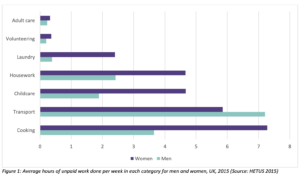 This proportion of unpaid work has increased between 2000 and 2015. Seeing that unpaid work is indispensable to both the function of society and the economy, feminist economists have argued for unpaid work to have recognition in systems of national accounting. These campaigns have led to the UK Office for National Statistics to develop estimates; the most recent from 2014 valuing unpaid care work £1.01 trillion.
This proportion of unpaid work has increased between 2000 and 2015. Seeing that unpaid work is indispensable to both the function of society and the economy, feminist economists have argued for unpaid work to have recognition in systems of national accounting. These campaigns have led to the UK Office for National Statistics to develop estimates; the most recent from 2014 valuing unpaid care work £1.01 trillion.
Limiting Opportunities for Paid Work: Women More Likely to Work Part-Time and Earn Less
This phenomenon puts a disproportionate strain on women and contributes to gender inequality. Mothers with young children are 3-4 times more likely to work part-time, and women, in general, are far more likely to be in precarious forms of employment such as temporary work. This is especially true for women of color. The part-time work conundrum is driving the gender gap, and on average women earn 43% less than men. Furthermore, a pay gap of 8.9% persists, further exacerbating this issue. Again, this being more predominate with women of color.
Despite women becoming increasingly educated, they persist in being overrepresented in low-wage sectors of the economy such as health and social work. Feminist economists have argued that a reason behind this is such sectors are viewed as an extension of a women’s “natural” work.
These issues create a perpetual cycle that allows for the inequality between men and women to continue.
Life Course Implications: Benefits Make Up a Larger Portion of Income and Austerity Hits Harder
Among single households living in poverty, those led by women make up for 86%. Furthermore, pensioners living alone are far more likely to be at the poverty level if that individual is a woman. Since tax reforms began in 2010 throughout the UK, women have also been hit hardest. These benefits make up a large portion of women’s incomes and cuts to these benefits and tax giveaways benefit those fitting into a higher wealth bracket.
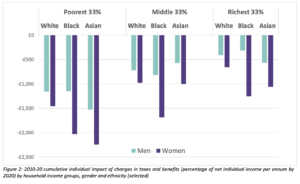
Public Services: Women Hit Hardest by Cutbacks
Cuts to public spending throughout the UK have also hit women disproportionately hard, as women are most likely to utilize public services. The poorest families and especially those in poverty-level households led by women have taken a particularly bad hit; many single mothers have had to cut living standards by up to 10% as a result of a cut to public services between 2010 and 2017.
Furthermore, these cuts have put a greater burden on family members to provide care for the elderly members of their family, much of this falling onto female members. This often comes at the expense of their own employment.
Violence Against Women: “Cause and Consequence” of Women’s Economic Equality
All of the factors that lead to the economic disparity between men and women also make it increasingly difficult for women to leave abusive partners. Furthermore, poorer households have higher rates of domestic abuse, and this perpetuating poverty limits women’s options while increasing their vulnerability.
Moving Forward: Next Steps for the Commission
The WBG Commission on a Gender-Equal Economy is striving to develop an alternative economic approach aimed at addressing these issues. Through this initiative, they aim to build an economy that is desirable, economically feasible, and necessary for fairness, sustainability, and resilience. To learn more about the Commission and its work, sign up to attend the upcoming webinar “Creating a Caring Economy: A Call to Action” on September 30, 2020.
This blog was authored by Jenn Brown, CWE-GAM Communications Assistant
- Published in Child Care, Feminist Economics, Gender Inequalities, Gender-Equal Economy
Biden’s Care Plan Has the Potential to Change Care Work in the U.S. for the Better
Joe Biden has officially accepted the Democratic Presidential nomination, and he and his team plan to make substantial investments in the infrastructure of care in the U.S. if he wins in the Presidential election. The potential of this plan to provide much-needed support for care workers, both paid and unpaid, is more important than ever amidst the pandemic.
Even prior to this pandemic, the U.S. has long suffered a caregiving crisis. Family caregiving needs often come with incredible financial, emotional, and professional burdens. Professional caregivers, disproportionately women of color, have long been underpaid and undervalued. The pandemic has exacerbated these issues, leaving parents struggling to find the care services needed while juggling careers. There are a number of measures that have been proposed by the Biden team to address the many issues currently plaguing the overall care system in the U.S. today.
Elderly individuals in nursing homes are feeling an increasing need to be cared for at home rather than in community living situations where they are more vulnerable to COVID-19 exposure. The Biden care plan addresses this by aiming to close the existing Medicaid gap to allow for home and community-based care services while creating a state innovation fund for cost-effective direct care services. This will provide more affordable and accessible care on that front. This step will also help to alleviate the extensive waitlists now existing for those under Medicaid to enter home and community care programs, providing these services for 800,000 individuals. If implemented properly, this initiative allows the opportunity to provide more functional care systems that grant greater independence to elderly individuals, while also freeing many unpaid care workers, such as family members, to pursue professional endeavors.
This plan also proposes increasing wages and benefits for caregivers and early childhood educators while providing opportunities for training, professional growth, and unions. This particular initiative takes into consideration the fact that early childhood development is incredibly important, and quality childcare is essential for children to grow into healthy, productive members of society. Universal preschool will also be provided via tax credits and sliding scale programs. Furthermore, included is an investment into safe and developmentally appropriate childcare facilities, including bonus pay for those providers that operate non-traditional hours, such as early mornings, late evening, and weekends. By increasing access to childcare centers with more flexible hours, the burden for many families will be lifted; currently, many parents that don’t work traditional Monday through Friday hours are left scrambling to find adequate care. These initiatives overall will have significant positive impacts on working parents, particularly women. Far too often, women find themselves sacrificing professional progression and development due to the constraint of inadequate or unaffordable childcare.
For those parents who grapple with the decision to further their education as a result of unaffordable and reliable care, investment in childcare centers at community colleges is also included in this plan.
Lastly, expanding the awareness of the Department of Defense fee assistance childcare programs so that all military spouses have the ability to pursue their professional development and education.
In order to pay for these initiatives, the Biden team has estimated a cost of $775 billion over the span of ten years, to be funded by rolling back certain tax breaks for those earning over $400,000 annually. A $5000 tax credit or Social Security credits for those providing unpaid care for members of their family is also proposed. Further, the plan seeks to offer low- and middle-class families up to $8000 in tax credits to assist in paying for childcare. For those that choose not to claim this credit, high-quality care is to be provided on a sliding scale, where it is estimated that families will not pay over $45 per week.
Although this plan is incredibly ambitious, and its implementation is not a guarantee, it sets a precedent that has been long lacking within the U.S. care work sphere. Implementation of these initiatives on any scale would prove beneficial to both the paid and unpaid care economy.
This blog was authored by Jenn Brown, CWE-GAM Communications Assistant
- Published in Child Care, elderly care, Policy, U.S.
The True Cost of Caregiving: An Aspen Institute Digital Discussion
Even in a typical year, U.S. households are estimated to experience $31.9 billion in lost wages as a result of inadequate childcare and paid leave. Roughly 1 in 5 people living in the U.S. today incur caregiving expenses, and the need for care work is experienced in nearly every household at least once. Those who are professional care workers, disproportionately women of color, are underpaid and therefore susceptible to financial insecurity. Those insecurities have been exacerbated even further amidst COVID-19 and the resulting economic downturn.
In June 2020, the Aspen Institute Business and Society Program hosted a digital discussion “Paid Leave, Livable Wage, Affordable Care: Policies that Could Avert the Next Crisis” in conjunction a policy brief “The True Cost of Caregiving” that was released in May. Within this discussion, the panel focused on the fragility of the care system and the financial stability of those providing care, both paid and unpaid. The panel not only addresses these issues but seeks to re-imagine a system in which care is treated like a public good, examines the hierarchy of human value, delves into the historical context behind care work in the U.S., the vulnerability of care workers in the current pandemic, and the inefficiency of the current care economy within the larger economic system.
A number of important questioned are addressed such as:
– How to quantify the benefits of paid leave, livable wages, and affordable care policies?
-What are feasible policy responses to COVID-19, in both the short term and long term, that can lead to better systems of caregiving in the U.S?
-What does an inclusive and equitable care system could look like?
-Who bears responsibility for building this system?
Further, this panel brings to the table the idea that care work should be invested in collectively as a nation, as opposed to being looked at as an individual burden; which puts increasing downward pressure on those who are already disadvantaged in the U.S. due to race and gender.
Policies that address these concerns could assist in not only building a more equitable system of care but have the potential to aid in averting future crises like that which the care economy finds itself in today.
- Published in Child Care, Expert Dialogues & Forums, Policy, U.S.
Inequalities in access to U.S. care services
In the U.S., states and localities are beginning to ease social distancing policies resulting from the pandemic. With many workplaces calling Americans to return to work, the nation’s care services system, what was already broken, is now in dire need of repair or replace.
According to a recent analysis by the Center for American Progress (CAP), the lack of adequate child care services in the U.S. negatively affected communities of color before the pandemic, as parents of color were more likely than their non-Hispanic white counterparts to experience child care-related job disruptions that could affect their families’ finances.
The analysis uses the National Survey of Children’s Health (NSCH) to show that before the pandemic, Black and multiracial parents experienced child care-related job disruptions—such as quitting a job, not taking a job, or greatly changing their job—due to problems with child care at nearly twice the rate of white parents.
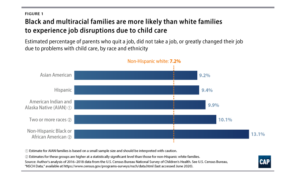
For Black workers and workers of color, decades of occupational and residential segregation has translated to less access to telework, and therefore less flexibility within their responsibilities for young children or elders. In fact, most Black workers and workers of color (especially those who are women) have had to work through the pandemic in essential frontline occupations.
The analysis shows that prior to the pandemic, adequate and affordable child care services was short in supply, particularly for Black, Latinx, and Indigenous families. In fact, more than half of Latinx and American Indian and Alaska Native (AIAN) families have experiences living in a child care desert – which is an area suffering from an inadequate supply of licensed childcare.
Using child care services as an example, the analysis shows that disparities will likely worsen in the aftermath of the pandemic. A previous CAP analysis estimated that nearly 4.5 million child care slots could disappear permanently as a result of COVID-19, effectively cutting an already inadequate child care supply in half. Recent data suggest that this impact is already being felt, with more than 336,000 child care providers—many of whom are immigrants, African American, or Hispanic—losing their jobs between March and April.
Allowing care services to flounder should not be an option; a broken and inadequate care system would slow the nation’s economic recovery and in addition to deepening existing economic and racial inequalities.
This blog was authored by Shirin Arslan, Program Manager for the Care Work and the Economy Project
- Published in Child Care, Gender Inequalities, Race Inequality
Frontline Care Workers in the U.S.
A recent report on Basic Demographic Profile of Workers in U.S. Frontline Industries by the Center for Economic and Policy Research (CEPR) looks at six broad industries, employing grocery store clerks, warehouse workers, bus drivers, and care workers – including nurses, care workers at child care and residential care facilities, as well as household and community service workers.
Based on CEPR’s analysis using the American Community Survey (2014 – 2018), over half of all essential workers in the industries examined are employed in care services. More than a third of these workers are over the age of 50; and before the pandemic, nearly a quarter were living in low-income households and about half lived with a child or a senior at home.
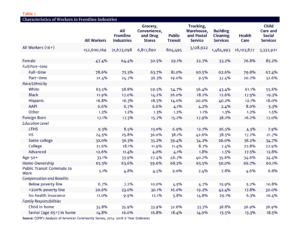
At the national level, women workers are overrepresented in frontline industries. About one-half of all workers are women, but nearly two-thirds (64.4 percent) of frontline workers are women. Women are particularly overrepresented in care-work related industries – Healthcare (76.8 percent of workers) and Child Care and Social Services (85.2 percent).
Black and Hispanic workers, as well as other people of color are also overrepresented in many frontline industries occupations. Black workers are most overrepresented in Child Care and Social Services (19.3 percent of workers). Hispanic workers are especially overrepresented in Building Cleaning Services (40.2 percent). Immigrants are also overrepresented in Building Cleaning Services and in many frontline occupations in other frontline industries.
The report calls on U.S. congress to include important protections for frontline workers in its response to COVID-19 – including comprehensive health-care insurance, paid sick and family leave, free child-care, student loan relief and other labor protections related to workers’ health, safety and immigration status.
About the report:
A Basic Demographic Profile of Workers in Frontline Industries. Hye Jin Rho, Hayley Brown, and Shawn Fremstad. Center for Economic and Policy Research. April 2020.
- Published in Child Care, COVID 19

